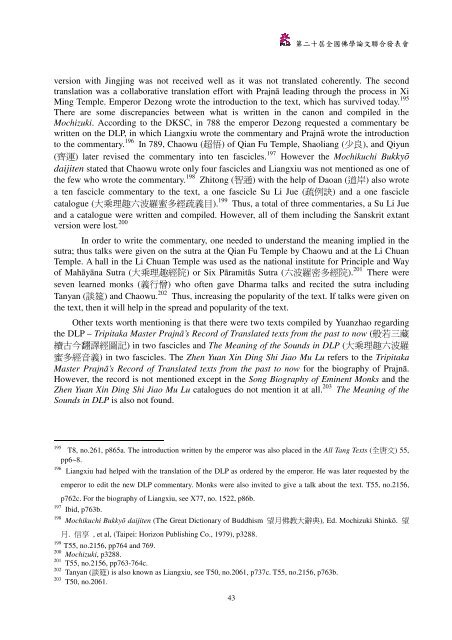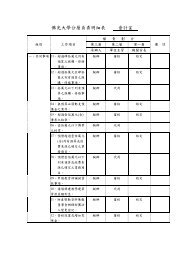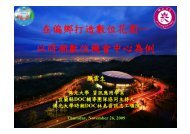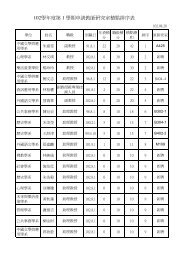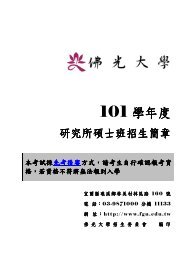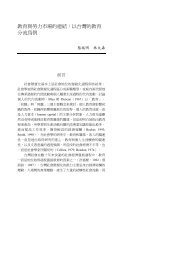【A 場】第一場論文集 - 佛光大學
【A 場】第一場論文集 - 佛光大學
【A 場】第一場論文集 - 佛光大學
- No tags were found...
You also want an ePaper? Increase the reach of your titles
YUMPU automatically turns print PDFs into web optimized ePapers that Google loves.
第 二 十 屆 全峖 國 佛 學 論 文尠 聯 合峯 發 表 會version with Jingjing was not received well as it was not translated coherently. The secondtranslation was a collaborative translation effort with Prajnā leading through the process in XiMing Temple. Emperor Dezong wrote the introduction to the text, which has survived today. 195There are some discrepancies between what is written in the canon and compiled in theMochizuki. According to the DKSC, in 788 the emperor Dezong requested a commentary bewritten on the DLP, in which Liangxiu wrote the commentary and Prajnā wrote the introductionto the commentary. 196 In 789, Chaowu ( 超 悟韷 ) of Qian Fu Temple, Shaoliang ( 少 良候 ), and Qiyun( 齊猗 運跮 ) later revised the commentary into ten fascicles. 197 However the Mochikuchi Bukkyōdaijiten stated that Chaowu wrote only four fascicles and Liangxiu was not mentioned as one ofthe few who wrote the commentary. 198 Zhitong ( 智 通 ) with the help of Daoan ( 道跰 岸 ) also wrotea ten fascicle commentary to the text, a one fascicle Su Li Jue ( 疏 例 訣 ) and a one fasciclecatalogue ( 大 乘靭 理 趣賱 六 波 羅訌 蜜犪 多 經 疏 義 目 ). 199 Thus, a total of three commentaries, a Su Li Jueand a catalogue were written and compiled. However, all of them including the Sanskrit extantversion were lost. 200In order to write the commentary, one needed to understand the meaning implied in thesutra; thus talks were given on the sutra at the Qian Fu Temple by Chaowu and at the Li ChuanTemple. A hall in the Li Chuan Temple was used as the national institute for Principle and Wayof Mahāyāna Sutra ( 大 乘靭 理 趣賱 經 玽 ) or Six Pāramitās Sutra ( 六 波 羅訌 密 多 經 玽 ). 201 There wereseven learned monks ( 義 行 僧踶 ) who often gave Dharma talks and recited the sutra includingTanyan ( 談 筵牧 ) and Chaowu. 202 Thus, increasing the popularity of the text. If talks were given onthe text, then it will help in the spread and popularity of the text.Other texts worth mentioning is that there were two texts compiled by Yuanzhao regardingthe DLP – Tripitaka Master Prajnā’s Record of Translated texts from the past to now ( 般獭 若 三 藏續 古 今 翻 譯 經 圖蹙 記玐 ) in two fascicles and The Meaning of the Sounds in DLP ( 大 乘靭 理 趣賱 六 波 羅訌蜜犪 多 經 音靦 義 ) in two fascicles. The Zhen Yuan Xin Ding Shi Jiao Mu Lu refers to the TripitakaMaster Prajnā’s Record of Translated texts from the past to now for the biography of Prajnā.However, the record is not mentioned except in the Song Biography of Eminent Monks and theZhen Yuan Xin Ding Shi Jiao Mu Lu catalogues do not mention it at all. 203 The Meaning of theSounds in DLP is also not found.195T8, no.261, p865a. The introduction written by the emperor was also placed in the All Tang Texts ( 全 唐鞡 文 ) 55,pp6~8.196Liangxiu had helped with the translation of the DLP as ordered by the emperor. He was later requested by theemperor to edit the new DLP commentary. Monks were also invited to give a talk about the text. T55, no.2156,p762c. For the biography of Liangxiu, see X77, no. 1522, p86b.197 Ibid, p763b.198 Mochikuchi Bukkyō daijiten (The Great Dictionary of Buddhism 望 月 佛 教 大 辭訶 典 ), Ed. Mochizuki Shinkō. 望月 . 信 享 , et al, (Taipei: Horizon Publishing Co., 1979), p3288.199T55, no.2156, pp764 and 769.200 Mochizuki, p3288.201 T55, no.2156, pp763-764c.202 Tanyan ( 談 筵牧 ) is also known as Liangxiu, see T50, no.2061, p737c. T55, no.2156, p763b.203 T50, no.2061.43


